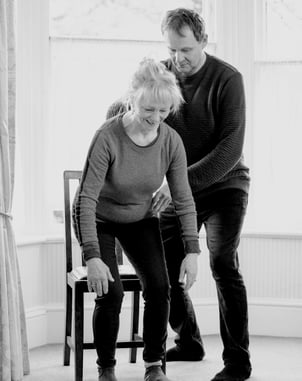

Regain freedom and poise in movement
The Alexander Technique is a practical method that teaches you to recognize and release unhelpful habits of movement and posture, enabling you to move with greater ease, efficiency, and comfort in all aspects of your life.
Reclaim Your Body's Innate Intelligence
Do you experience persistent aches, stiffness, or discomfort? Are you looking for a sustainable way to improve your posture, reduce stress, and enhance your overall well-being? The Alexander Technique offers a unique approach that addresses the root cause of these issues, rather than just the symptoms.
Through gentle guidance and mindful awareness, you'll learn to:
Release unnecessary tension: Discover where you're holding tension in your body and learn how to let it go.
Improve coordination and balance: Re-establish your natural poise and move with greater fluidity.
Enhance breathing and vocal freedom: Experience a more expansive and effortless breath.
Reduce pain and discomfort: Learn self-management skills for long-term relief from chronic conditions.
Boost confidence and presence: Carry yourself with greater ease and self-assurance.
Back Pain Relief: Evidence-Based Results
The effectiveness of the Alexander Technique for chronic back pain is supported by robust scientific research. A landmark study published in the British Medical Journal (BMJ) in 2008 demonstrated significant long-term benefits for individuals suffering from chronic low back pain.
The study, a randomized controlled trial involving 579 patients, found that:
24 Alexander Technique lessons led to an average 86% reduction in days of pain per month even 12 months after lessons were completed, compared to a control group.
Even six lessons, combined with GP-prescribed exercise, were nearly as effective as 24 lessons in reducing pain and improving function.
Participants experienced significant improvements in their ability to carry out daily activities without being limited by back pain, alongside an enhanced quality of life.
No adverse events were reported, highlighting the safety of the Alexander Technique.
This pioneering research provides strong evidence that Alexander Technique lessons offer a safe and highly effective approach to managing chronic back pain, empowering individuals with practical self-care skills for lasting relief.
Presence: Connecting to Your Body
At the heart of the Alexander Technique lies a profound emphasis on presence – the Technique invites you to become intimately aware of your body in each moment.
Many of our habitual patterns of tension and misuse can stem from being lost in thought, disconnected from our physical selves. By bringing conscious awareness to how we sit, stand, and move, we begin to inhabit our bodies more fully and respond to stimuli with greater intention rather than unconscious reaction.
Through Alexander Technique lessons, you'll cultivate a heightened sense of:
Mindful awareness: Noticing your physical reactions and choices in real-time.
Non-doing: Learning to "stop" unhelpful habitual responses before they take hold.
Spaciousness: Creating physical and mental freedom by releasing unnecessary effort.
This deeper connection to the present moment, more recently labelled as Mindfulness or extolled in the Eckhart Tolle's "Power of Now," allows for a more authentic and aligned way of being, fostering not only physical well-being but also a greater sense of inner peace and freedom.
Whether you're seeking relief from pain, improved performance, or simply a greater sense of ease in your daily life, the Alexander Technique offers a transformative learning experience.
Explore the possibilities and schedule your introductory lesson today.
A Scientific Model of how the Alexander Technique works

Benefits of the Alexander Technique:
Overcome back pain, neck and shoulder pain
Overcome repetitive strain injuries
Improve poise & posture
Improve balance and coordination
Reduce headaches and migraines
Reduce stress
Easier breathing
Can lower blood pressure







